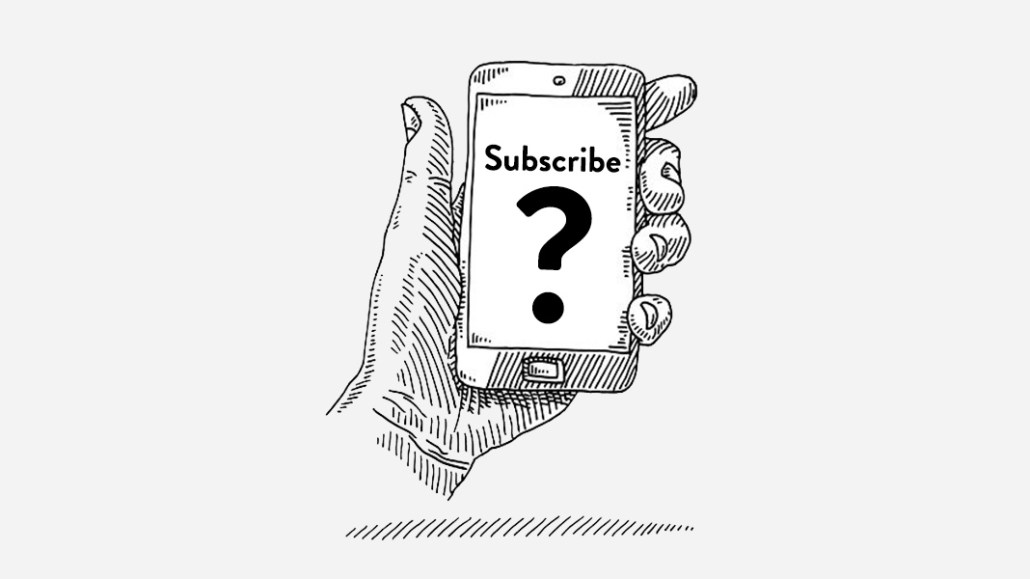Save 50% on a 3-month Digiday+ membership. Ends Dec 5.
‘More is more’: News publishers dial up the marketing heat on their subscription products

Publishers have gotten a lot pushier about marketing their news subscriptions lately.
With many of their ad businesses still shaky, particularly in local news, and with many now smarter about what kinds of offers convert the most users, publishers have been promoting their subscriptions more aggressively as the year has worn on.
Recent research conducted by the paywall platform Piano found that, among its publisher customers, the median percentage of site visitors who were shown a subscription offer was nearly three times higher in September than it was in March.
According to Piano’s research, around one in six site visitors saw an offer that month, said Michael Silberman, Piano’s svp of strategy, and that may under-represent how pushy publishers are being: One of the two mechanisms Piano customers can use to show offers to readers was not counted in the data, Silberman said.
The trend extended beyond Piano’s customer base. The Dallas Morning News, for example, has spent the past six months experimenting with more kinds of offers, moving away from long-term plays and toward shorter, more affordable deals instead.
Subscribe: Apple Podcasts | Stitcher | Google Play | Spotify
Ad position: web_incontent_pos1
Tribune Publishing, which owns newspapers including the Chicago Tribune and the New York Daily News, sent out emails to non-subscribers in all eight of Tribune’s markets highlighting the coronavirus coverage and other journalism supported by subscribers, then included the publisher’s most attractive offer: six months of access for $1.
“We took another approach,” said Idalmy Carrera-Colucci, vp of audience engagement and retention at Tribune Publishing, who noted that the company’s marketing strategy was informed, in part, by the publisher’s decision to put much of its coronavirus coverage in front of its paywall, a decision that is newly relevant as many parts of the country brace for second waves of infection this fall and winter..
The tactics are paying off. Gannett, which has been focused on standardizing the subscription promotions approach used across the more than 100 titles in its network, according to Gannett’s chief marketing and strategy officer, Mayur Gupta, announced in a quarterly earnings report released Nov. 3 that it had more than 1 million digital subscribers. That growth was notable not just because of the threshold Gannett crossed, but because that quarter’s growth — over 76,000 digital subscribers — was even stronger than what Gannett had posted in either of the previous two quarters, when many publishers saw huge spikes in subscription starts thanks in part to their coverage of the coronavirus crisis.
The Dallas Morning News posted 39% subscriber growth year over year in the third quarter, just as strong as the subscriber growth posted in the second quarter, according to filings made by parent company, A.H. Belo.
The aggressive marketing complements the work some publishers have done to tighten their own meters.
Ad position: web_incontent_pos2
Mark Campbell, the chief marketing officer of Hearst Newspapers, said subscriber growth at Hearst has continued to accelerate through the year (though he would not provide specific numbers), and that tightened paywalls played a major role. “What I’ve been finding is, more is more,” Campbell said. “A tighter meter will turn into more subs, even when the conversion rate takes a bit of a hit.”
The growth contrasts with the challenges news publishers face in their advertising businesses, many of which have been exacerbated this year. Print advertising fell 30% year over year in the third quarter for Gannett, for example.
Some of the pushiness came from publishers deemphasizing traditional, and now acutely challenged, advertising.
But some of it has bee the result of publishers finally getting infrastructure in place after months of work. The Dallas Morning News, for example, recently finished incorporating Arc’s subscriptions tools into its operations, more than a year after the Washington Post, which owns Arc, announced them.
The move, which required removing six different vendors’ technologies that had been integrated in-house, took almost as much time and manpower as switching to a new CMS, chief product officer Mike Orren said.
But the change also allowed them to start running more tests and promotions. Orren said the Dallas Morning News is going to start A/B testing subscription offers to readers, giving them a chance to better learn and optimize what it offers for their personal readership patterns and preferences. “We’re not going to be going too crazy,” Orren said. “But [more A/B testing] is where we’re going.”
More in Media

Digiday+ Research Subscription Index 2025: Subscription strategies from Bloomberg, The New York Times, Vox and others
Digiday’s third annual Subscription Index examines and measures publishers’ subscription strategies to identify common approaches and key tactics among Bloomberg, The New York Times, Vox and others.

From lawsuits to lobbying: How publishers are fighting AI
We may be closing out 2025, but publishers aren’t retreating from the battle of AI search — some are escalating it, and they expect the fight to stretch deep into 2026.

Media Briefing: Publishers turn to vertical video to compete with creators and grow ad revenue in 2026
Publishers add vertical video feeds to their sites to boost engagement, attract video ad spend and compete with news creators.
Ad position: web_bfu




